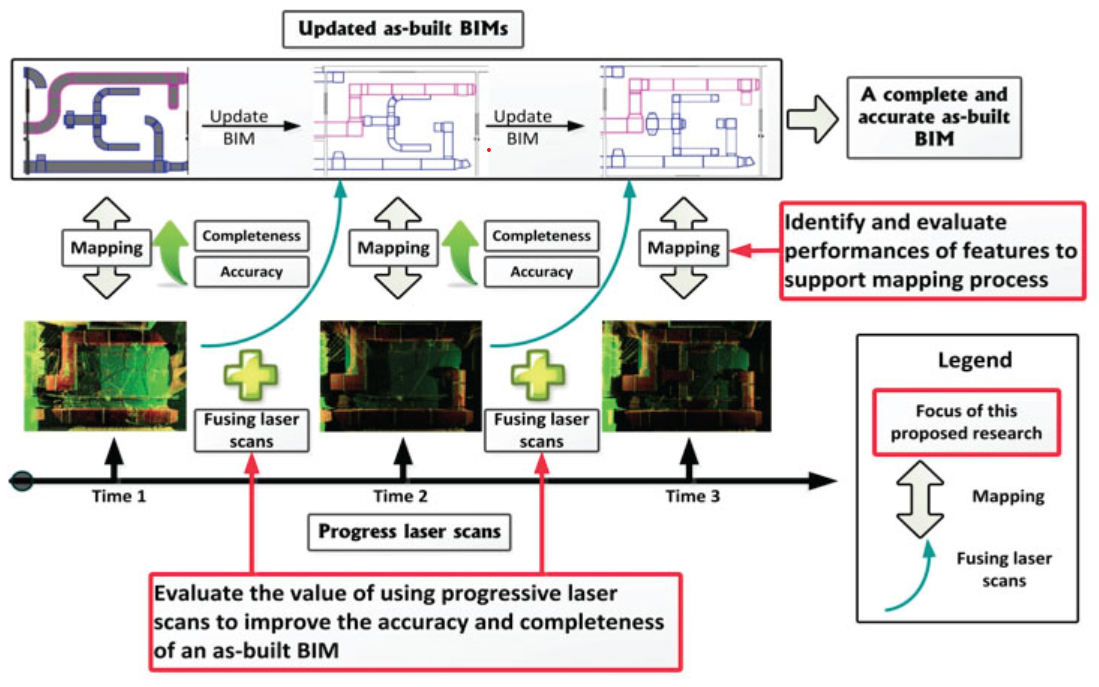 ‘ For every construction or renovation project, the general contractor is required to hand over the as-built documents to the owner or the facility management team at the end of the project. The main challenge for the handover process is to ensure the completeness of the captured building information and the accuracy of it in terms of how well it represents the reality. The report published by NIST in 2004 pointed out that $4.8 billion was spent every year just to verify that the captured building information represents accurate building conditions. Laser scanning technology is able to capture accurate geometric information in a timely manner. Hence point cloud data captured by laser scans can be used as the reference to update an as-designed BIM into the as-built BIM. However, two challenges were identified in relation to the process of updating an as-designed BIM into an as-built BIM: a point cloud is a collection of 3D points without any semantic information (e.g., which building component that a point belongs to), hence it is difficult to recognize and extract building components and their associated geometric information from point clouds; and occlusions and construction/renovation progress prevent the laser scanned data captured at a point in time from obtaining a comprehensive view of the building. In order to address these challenges, this research resulted in a framework that supports the update of an as-designed BIM into an as-built BIM by incorporating geometric information captured by progressive laser scans. The framework is composed of three main parts: identifying different types of features that contribute in recognizing the correspondences between a point cloud and an as-designed BIM; evaluating the performance of features for the mapping between a point cloud and an as-designed BIM; and leveraging point clouds captured by progressive laser scans to retrieve a complete view of the building and increase the accuracy of the updated BIM. This framework removes discrepancies between the design model and the actual building conditions, and provide an accurate (i.e., all the building components and their associated geometric information are captured in the as-built BIM) and complete (i.e., geometric information contained in the as-built BIM reflects actual building conditions) as-built BIM as a part of the as-built handover documents. ‘
‘ For every construction or renovation project, the general contractor is required to hand over the as-built documents to the owner or the facility management team at the end of the project. The main challenge for the handover process is to ensure the completeness of the captured building information and the accuracy of it in terms of how well it represents the reality. The report published by NIST in 2004 pointed out that $4.8 billion was spent every year just to verify that the captured building information represents accurate building conditions. Laser scanning technology is able to capture accurate geometric information in a timely manner. Hence point cloud data captured by laser scans can be used as the reference to update an as-designed BIM into the as-built BIM. However, two challenges were identified in relation to the process of updating an as-designed BIM into an as-built BIM: a point cloud is a collection of 3D points without any semantic information (e.g., which building component that a point belongs to), hence it is difficult to recognize and extract building components and their associated geometric information from point clouds; and occlusions and construction/renovation progress prevent the laser scanned data captured at a point in time from obtaining a comprehensive view of the building. In order to address these challenges, this research resulted in a framework that supports the update of an as-designed BIM into an as-built BIM by incorporating geometric information captured by progressive laser scans. The framework is composed of three main parts: identifying different types of features that contribute in recognizing the correspondences between a point cloud and an as-designed BIM; evaluating the performance of features for the mapping between a point cloud and an as-designed BIM; and leveraging point clouds captured by progressive laser scans to retrieve a complete view of the building and increase the accuracy of the updated BIM. This framework removes discrepancies between the design model and the actual building conditions, and provide an accurate (i.e., all the building components and their associated geometric information are captured in the as-built BIM) and complete (i.e., geometric information contained in the as-built BIM reflects actual building conditions) as-built BIM as a part of the as-built handover documents. ‘
Gao, T., Akinci, B., Ergan, S., and Garrett, J. (2013). “A framework to generate accurate and complete as-built BIMs based on progressive laser scans”, Proceedings of International Symposium on Automation and Robotics in Construction (ISARC), August 13-15, 2013, Montreal Canada, pp. 849-856. http://www.iaarc.org/publications/fulltext/isarc2013Paper240.pdf.
Gao, T., Akinci, B., Ergan, S., and Garrett, J. (2012). “Constructing as-is BIMs from progressive laser scan data”, Proceedings of International Symposium of Automation and Robotics in Construction: ISARC 2012, June 26-29, 2012, Eindhoven, the Netherlands, pp. 36-42. DOI: http://dx.doi.org/10.4017/gt.2012.11.02.500.685.
Gao, T., Ergan, S., Akinci, B., and Garrett, J. H. (2014). “Evaluation of different features for matching point clouds to building information models”, Journal of Computing in Civil Engineering, DOI: 10.1061/(ASCE)CP.1943-5487.0000425.
Gao, T., Akinci, B., Ergan, S., and Garrett, J. H. (2014). “Identification of features to be used for matching point clouds to BIMs”, Canadian Journal of Civil Engineering.
Gao, T., Akinci, B., Ergan, S., and Garrett, J. (2015). “An approach to combine progressively captured point clouds to increase the completeness of an as-built BIM.” Advanced Engineering Informatics (under review).
Gao, T., Ergan, S., Akinci, B., and Garrett, J. H. (2014). “Proactive productivity management at job sites: understanding characteristics of assumptions made for construction processes during planning based on case studies and interviews”, ASCE Journal of Construction Engineering and Management, 140(3), March issue, 1-11. DOI: 10.1061/(ASCE)CO.1943-7862.0000816.